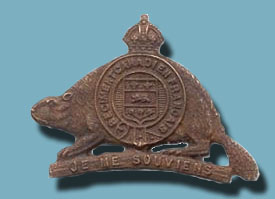Canadian Expeditionary Force

The ancestor of the regiment was formed in the early days of the First World War, when volunteers from all over Canada were being massed for training at Valcartier, Quebec, just outside of Quebec City. The first contingent of 30,000 volunteers, which became the 1st Canadian Division of the Canadian Expeditionary Force, were grouped into numbered battalions, regardless of origin. The existing reserve regiments were not mobilized, due to the belief of the Defence Minister, Sam Hughes, that a new "efficient" structure was required. In the process, the new structure failed to create French-speaking units, such as those that had existed in the reserves. Over 1000 French-Canadian volunteers were scattered into different English-speaking units. This was not an oversight. Ontario (Hughes's political base) was in the process of forbidding teaching in French, or of French, in the school system (Regulation 17), causing outrage in French Canada and a lack of support for the war of the "king and country" that was perceived as seeking to destroy the Francophone community in Canada.
The second contingent was based, more logically, on battalions
raised and trained in the various military districts in which they had
been recruited, but still on an impersonal numbered basis (with the
exception of some with a Highland or Irish identity). Considerable
political pressure in Quebec, along with public rallies, demanded the
creation of French-speaking units to fight a war that many viewed as
being right and necessary, despite the infamous Regulation 17 in
Ontario. When the government relented, the first such unit was the 22nd
(French Canadian) Infantry Battalion, CEF.
The 22nd went to France as part of the 5th Canadian Brigade and the
2nd Canadian Division in September 1915, and fought with distinction in
every major Canadian engagement until the end of the war. While other
French-speaking units were also created, they were all broken up upon
arrival in France to provide reinforcements for the 22nd, which
suffered close to 4000 wounded and killed in the course of the war. Two
members of the 22nd were awarded the Victoria
Cross in that war,
Lieutenant Jean Brillant and Corporal Joseph Kaeble.
(source: http://en.wikipedia.org/wiki/Royal_22e_R%C3%A9giment)